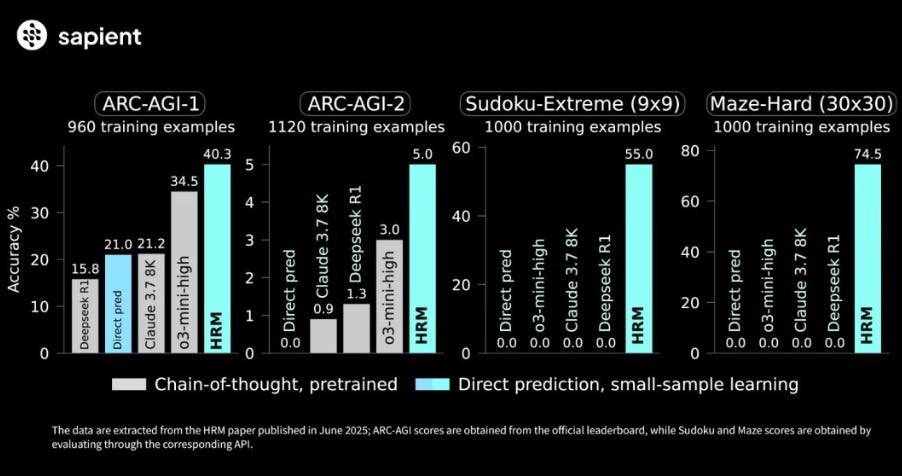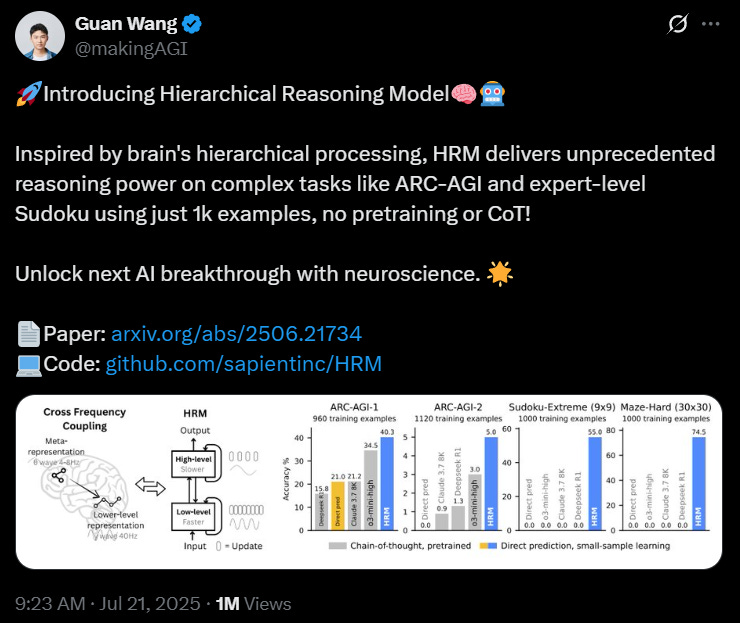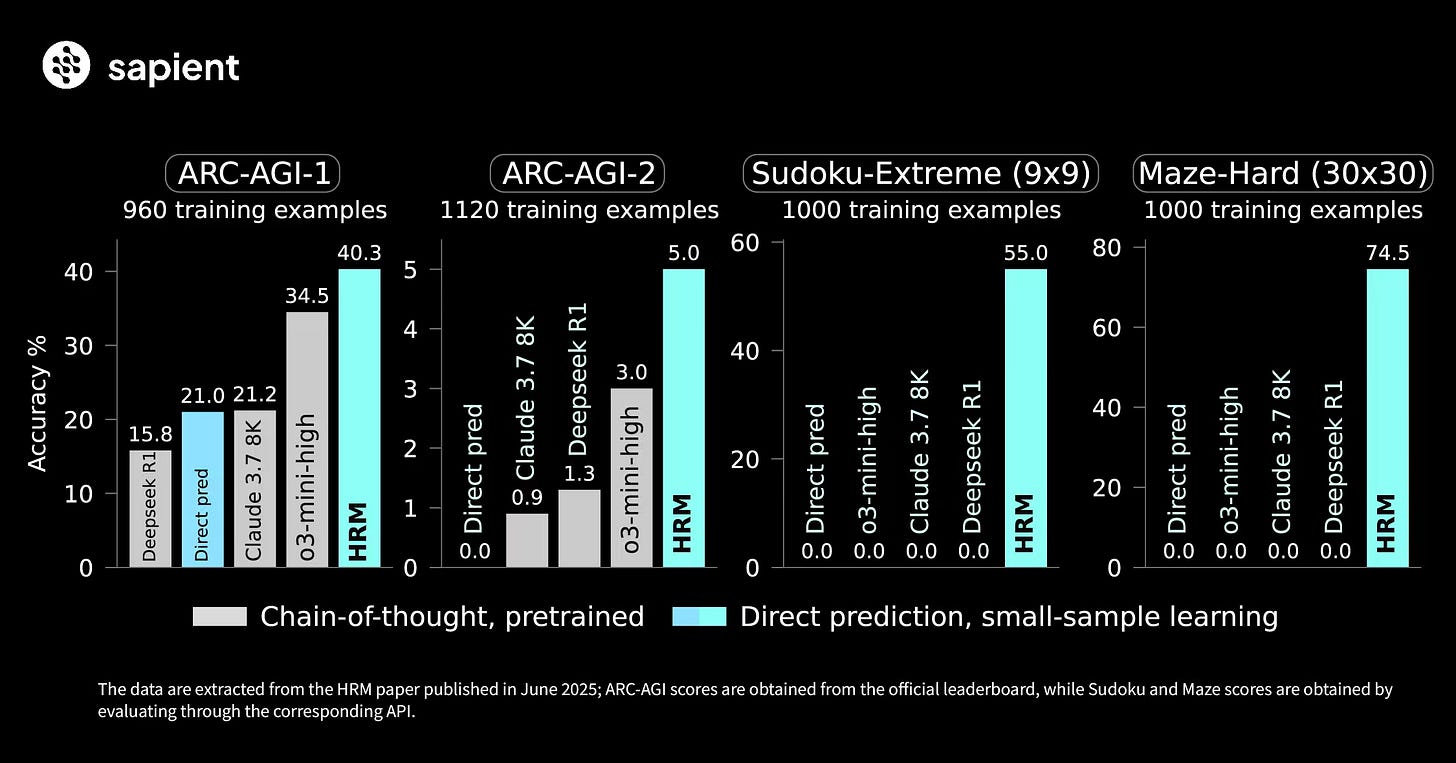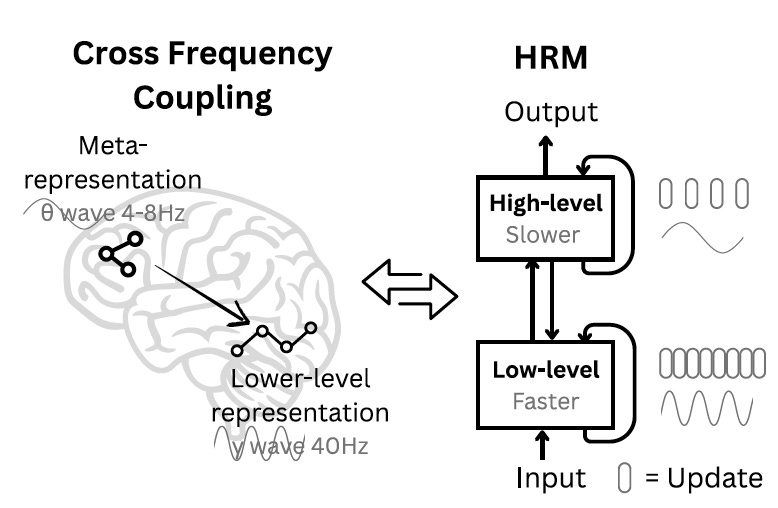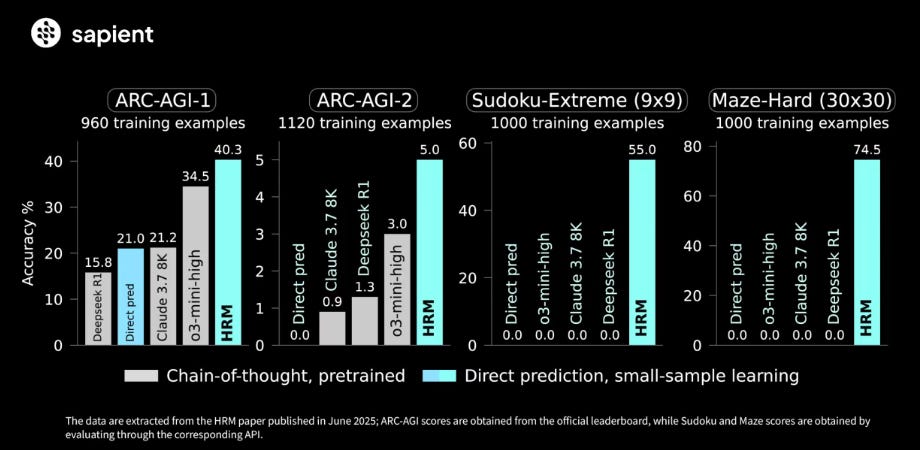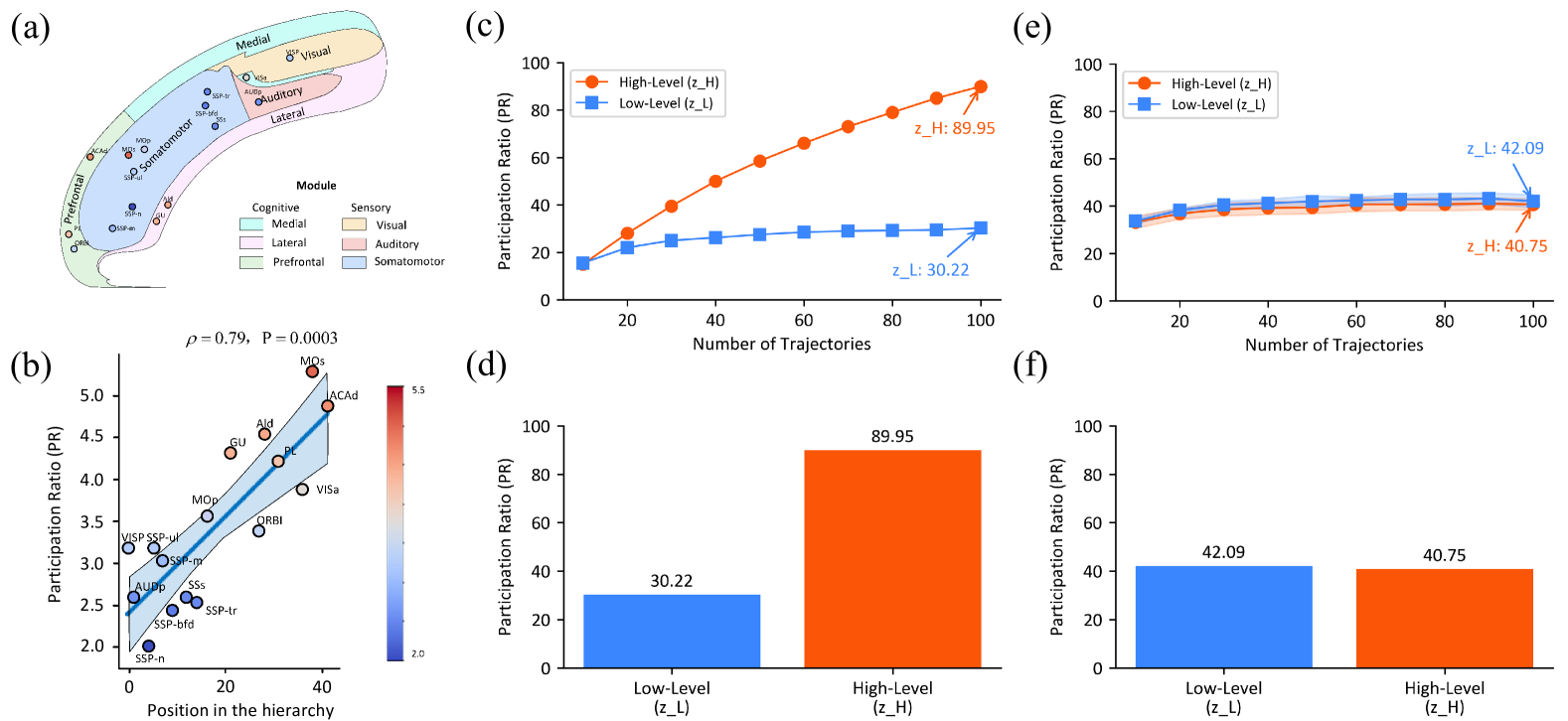What is Sapient Intelligence & Hierarchical Reasoning Model (HRM) ?
Is the quest for General Intelligence going to spawn new Architectures?
In January, 2025 a little known AI startup called Sapient Intelligence, a Singapore-based AI startup providing a self-evolving AI model for problem-solving, raised $22M in Seed funding, raising its valuation to over $200m. They were sort of on my radar being the AI startup sleuth that I am.
Today being a Singaporean AI Startup pretty much means that you are actually made up of AI talent from China.
They call themselves an “AGI research company” with headquarters in Singapore, with research centers in San Francisco and Beijing, building next-generation AI model for complex reasoning.
Sapient Intelligence is a provider of a self-evolving AI model designed for complex problem-solving.
Sapient Intelligence’s Hierarchical Reasoning Model (HRM) offers a powerful alternative to current CoT model training.
The PR makes some fantastic claims:
“New AI architecture delivers 100x faster reasoning than LLMs with just 1,000 training examples.”
The architecture, known as the Hierarchical Reasoning Model (HRM), is inspired by how the human brain utilizes distinct systems for slow, deliberate planning and fast, intuitive computation. And in this era where so much of what I’m covering are frontier models from China or related to top Chinese AI researchers, I think it’s worth knowing more about and digging into.
Neuroscience inspired AI?
I like the ideological and technical setup that the founders claim:
Enhanced Problem-Solving: Overcomes limitations of traditional GPT-style autoregressive models, excelling in intricate challenges.
Neuroscience-Inspired Architecture: Integrates transformer components with recurrent neural networks, mimicking brain-like information processing.
Multi-Step Reasoning: Delivers superior performance on tasks requiring advanced reasoning and contextual understanding.
New Architectures are coming to compete with the Transformer LLM based one
According to the team, the model achieves impressive results with a fraction of the data and memory required by today’s LLMs. This efficiency could have important implications for real-world enterprise AI applications where data is scarce and computational resources are limited.
With only 27 million parameters, HRM achieves exceptional performance on complex reasoning tasks using only 1000 training samples.
In July 2025, the practically unknown AI startup introduced the Sapient Hierarchical Reasoning Model (HRM), a hierarchical, brain-inspired model that achieves deep reasoning with minimal data.
AI Talent Much?
Their growing team apparently includes alumni of Google DeepMind, DeepSeek, Anthropic, and xAI, alongside researchers from Tsinghua University, Peking University, UC Berkeley, the University of Cambridge, and the University of Alberta, working together to close the gap between today’s language models and true general intelligence.
So What?
HRM achieves near-perfect accuracy on tasks like Sudoku-Extreme and Maze-Hard, and scores 5% on the ARC-AGI-2 benchmark, outperforming larger models like OpenAI’s o3-mini-high, DeepSeek R1, and Claude 3.7 8K. Its efficiency makes it suitable for applications in healthcare diagnostics, climate forecasting (97% accuracy in subseasonal-to-seasonal predictions), and robotics as an on-device decision-making system. The model runs on standard CPUs with under 200MB RAM, offering low-latency performance for real-time use.
These are the authors of the paper: Guan Wang, Jin Li, Yuhao Sun, Xing Chen, Changling Liu, Yue Wu, Meng Lu, Sen Song, Yasin Abbasi Yadkori.
They rightfully argue against the limitations of CoT approach.
In their paper, researchers at Sapient Intelligence argue that “CoT for reasoning is a crutch, not a satisfactory solution. It relies on brittle, human-defined decompositions where a single misstep or a misorder of the steps can derail the reasoning process entirely.” As we are seeing with agents in real-life scenarios, they are not performing very well in many cases in 2025.
Towards Long-Horizon Reasoning Tasks
I wouldn’t call this an AGI lab. They are a small team but obviously well get more funding. As a fan of Singapore’s curious quasi-agnostic geopolitical location, and living in Taiwan it does intrigue me though. The startup Sapient Intelligence claims to be a Singapore's first foundation model AI startup focused on developing a new generation of foundational model architectures designed to solve complicated and “long-horizon reasoning” tasks. The company aims to address the limitations of traditional GPT-style models through an innovative approach that blends Transformer components with recurrent neural network structures, inspired by neuroscience.
Their models have demonstrated remarkable capabilities in various tasks where LLMs show many limitations.
Sapient Intelligence is redefining AI capabilities by addressing the shortcomings of conventional models in handling complex, multi-step problems.
Sapient Intelligence was founded by Guan Wang and William Chen in 2024. Feel free to visit https://www.sapient.inc/team for more details.
These are the kinds of folk that Meta Superintelligence Lab have poached from the likes of OpenAI, Google DeepMind Apple and other teams where Chinese first generation immigrants feature prominently.

Guan Wang, CEO & Founder - (see his account on X)
B.Sc. in Computer Science, Tsinghua University
Author of the open-source model OpenChat (A 7B model Outperforming the 70B Llama2, 5.4k GitHub stars, 200K+ monthly downloads on Hugging Face)
Lead Developer of OpenOrca, a leading Open-source LLM
Reinforcement Learning (RL) expert, with prior roles at the Tsinghua Laboratory of Brain and Intelligence, Shanghai AI Laboratory, and Pony.ai
William Chen, Co-founder & Head of Strategy and Management
B.Eng. in Mechanical Engineering, Tsinghua University; awarded the Tsinghua “Zhao Ping–Gao Rong” Scholarship
Venture development and commercialization at Tsinghua Innovation Center, serviced 20+ projects in areas such as artificial intelligence, medical engineering, and robotics
Development Team Lead, Research Engineer at DJI Innovations, Hesai Tech
Dev experiences in LLM‑based AI aviation command system, robotic prosthetics, medical agent, etc.
Venture Capital Investors
They have raised 22 million in seed funding, led by Vertex Ventures and CMBC International, with participation from JAFCO, Sumitomo Group, and others.
Future Considerations
I consider Sapient Intelligence an intriguing company to do pioneering work in Embodied intelligence (Physical AI and robotics), autonomous coding agents among other real-world applications.
It’s also not often you hear about pioneering Singapore based AI research labs. I have always found the idea of neurological and neuro-symbolic based architectures or influenced systems fairly interesting though I’m not sure where in the spectrum this falls exactly without further study.
When an AI startup is pre-Series A like this, it’s an exciting time in their life-cycle.
Sapient team turned to neuroscience for a solution. “The human brain provides a compelling blueprint for achieving the effective computational depth that contemporary artificial models lack,” the researchers write. “It organizes computation hierarchically across cortical regions operating at different timescales, enabling deep, multi-stage reasoning.”
Benchmark Breakthroughs
Despite its compact scale of 27 million parameters and using only 1000 input-output examples, all without any pre-training or Chain-of-Thought supervision, HRM learns to solve problems that even the most advanced LLMs struggle with.
In the Abstraction and Reasoning Corpus (ARC) AGI Challenge, a widely accepted benchmark of inductive reasoning, HRM archives a performance of 5% on ARC-AGI-2, significantly outperforming OpenAI o3-mini-high, DeepSeek R1, and Claude 3.7 8K, all of which rely on far larger sizes and context lengths. In complex Sudoku puzzles and optimal pathfinding in 30x30 mazes, where state-of-the-art CoT methods completely fail, HRM delivers near-perfect accuracy.
If this is true, their HRM models have interesting capabilities.
On the ARC-AGI benchmark, a test of abstract reasoning and generalization, the 27M-parameter HRM scored 40.3%.
This new benchmark is a popular one for so-called AGI research labs in 2025.
While they have offices in Singapore and Silicon Valley, if I had to guess their HQ is located in Beijing.
HRM is a Hierarchical Reasoning Model with Two Independent Modules
Sapient AI's HRM refers to the Hierarchical Reasoning Model, a novel AI architecture designed to mimic human-like reasoning with a focus on efficiency and performance in complex tasks. Unlike traditional large language models that rely on extensive pretraining and Chain-of-Thought (CoT) techniques, HRM uses a recurrent architecture with two interdependent modules: a high-level module for slow, abstract planning and a low-level module for rapid, detailed computations. This allows it to execute sequential reasoning tasks in a single forward pass without explicit supervision of intermediate steps.
Some of the claims on the performance boost of HRM truly does sound incredible:
“Instead of the serial, token-by-token generation of CoT, HRM’s parallel processing allows for what Wang estimates could be a “100x speedup in task completion time.” This means lower inference latency and the ability to run powerful reasoning on edge devices.”
On July 21, 2025 they open-sourced their HRM model.
Sapient Intelligence is already working to evolve HRM from a specialized problem-solver into a more general-purpose reasoning module and with Series A funding that will be made a lot easier. It’s still early days for this alternative approach to LLMs.
Their Neurological-Brain analogy is a bit less clear to me but it’s fairly interesting.
Real-World Impact
Healthcare
Robotics
Climate forecasting
The company believes HRM’s data efficiency and reasoning accuracy open new opportunities in fields where large datasets are scarce yet accuracy is critical.
For example, in healthcare, Sapient is partnering with leading medical research institutions to deploy HRM to support complex diagnostics, particularly rare-disease cases where data signals are sparse, subtle, and demand deep reasoning.
In climate forecasting, HRM raises subseasonal-to-seasonal (S2S) forecasting accuracy to 97 %, a leap that translates directly into social and economic value.
In robotics, HRM’s low-latency, lightweight architecture serves as an on-device “decision brain,” enabling next-generation robots to perceive and act in real time within dynamic environments.
The paper is just 24 pages long, so we have to take it with a grain of salt. However we need more alternatives to CoT and how our current architectures operate and China is able to delivery many new novel ideas around this as we have seen already in 2025.
Ben Dickson at Venturebeat did considerable PR for them in this article.
“Developing a model with the reasoning power of the brain has long been a goal in brain-inspired computing.”
Having specialized models for specific kinds of real-world tasks makes a lot of sense and new kinds of reasoning models show a lot of potential.
Here are some comments on Hacker News.
Overall I find their novel HRM approach fairly decent in terms of the many “alternative” architectures out there that are seeking new approaches to AI.
However it’s extremely early on the whole. I do think if a new architecture emerges it’s most likely to come out of Chinese AI researchers. (otherwise I wouldn’t be covering them).
Read impressions about this on Reddit.
When you are promising breakthroughs by marrying RL and Neuroscience, it’s extremely attractive to me!
Sapient Intelligence, with research centers in San Francisco and Beijing, aims to advance AGI through architectures integrating reinforcement learning, evolutionary algorithms, and neuroscience.
Follow their official account on X.
The model’s dual-module system, mimicking human planning and execution, is frequently noted as a breakthrough in AI reasoning. However, these claims come from Sapient’s own reports and lack independent verification, as no trained checkpoint or evaluation logs are publicly available.
Please review the comments on this Tweet for more ideas on verification.
Further information and data is required, but in my AI startup watching certainly caught my attention this week.
References:
Hierarchical Reasoning Model - arXiv official paper, https://arxiv.org/html/2506.21734v2
Sapient Intelligence: Official HRM GitHub Repository https://github.com/sapientinc/HRM
New AI architecture delivers 100x faster reasoning than LLMs with just 1,000 training examples, https://venturebeat.com/ai/new-ai-architecture-delivers-100x-faster-reasoning-than-llms-with-just-1000-training-examples/
Sapient Intelligence launches brain-inspired AI model for complex reasoning, https://www.investing.com/news/company-news/sapient-intelligence-launches-braininspired-ai-model-for-complex-reasoning-93CH-4144308
Sapient Intelligence Open-Sources Hierarchical Reasoning Model https://www.openpr.com/news/4112539/sapient-intelligence-open-sources-hierarchical-reasoning
Reddit Discussion: HRM Benchmarks and Results https://www.reddit.com/r/singularity/comments/1m6idg8/introducing_hierarchical_reasoning_model_delivers/
ARC-AGI Benchmark (official site and overview) https://arcprize.org/arc-agi
arXiv: "The Curse of CoT: On the Limitations of Chain-of-Thought in In-Context Learning" https://arxiv.org/abs/2504.05081
The Hierarchical Reasoning Model (HRM): Charting a New Path for Artificial Intelligence https://www.linkedin.com/pulse/hierarchical-reasoning-model-hrm-charting-new-path-neven-dujmovic-w0fsf/




